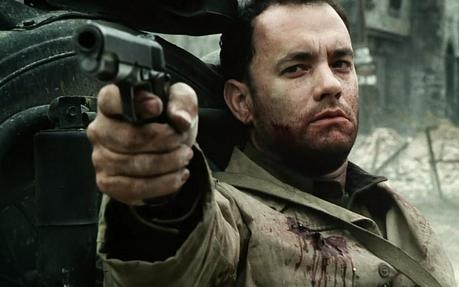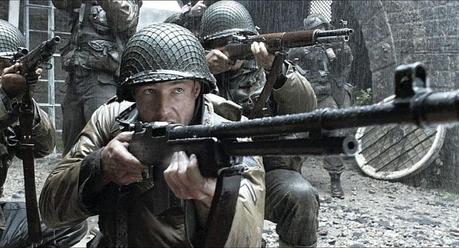 Saving Private Ryan (1998) was easily the most influential war movie in decades. Steven Spielberg's World War II epic indelibly shaped American perception of that conflict, not to mention the innumerable films, miniseries and video games who've borrowed its style. Ryan shares its virtues and flaws with Spielberg's other '90s critical darling, Schindler's List: striking presentation mixed with problematic storytelling.
Saving Private Ryan (1998) was easily the most influential war movie in decades. Steven Spielberg's World War II epic indelibly shaped American perception of that conflict, not to mention the innumerable films, miniseries and video games who've borrowed its style. Ryan shares its virtues and flaws with Spielberg's other '90s critical darling, Schindler's List: striking presentation mixed with problematic storytelling. Captain John Miller (Tom Hanks) leads an Army Ranger company on D-Day, suffering heavy casualties. As Miller's men recover, he's handed an improbable mission. Three members of the Ryan family have died in combat, convincing General George Marshall (Harve Presnell) to rescue the last, James Ryan (Matt Damon). Problem is, Ryan's serving with the 101st Airborne, his company stranded miles behind enemy lines. Milller leads a handpicked squad to rescue, all the while wondering.
Saving Private Ryan is a game changer on numerous levels. Undoubtedly it shapes our view of the Greatest Generation, whether in the iconic battle footage, solemn tone or John Williams' funereal score. Spielberg deserves credit for rescuing WWII films from its descent into soulless commando spectacles, granting the subject both gravity and immediacy. Many hate the framing device, with an aged Ryan revisiting Normandy, but it serves Spielberg's purpose: this could be your dad or grandpa. As a relative of several veterans, it's always struck a chord.
Everyone remembers Ryan's curtain-raiser, the jaw-dropping recreation of Omaha Beach. Spielberg trades the ennobling grandeur of The Longest Day for grisly chaos. Bullets and shrapnel reduce soldiers into quivering sinew; half of Miller's men don't even make it off the transport. Spielberg enhances things with disconcerting effects: soldiers dodging bullets underwater, Miller temporarily deafened by mortar rounds, dizzying handheld camerawork. It's 20 minutes of unrestrained carnage, surely the most horrifying combat footage in Hollywood history.
 The post-Ryan wave of ultra-violent battle epics (We Were Soldiers, Black Hawk Down) burned itself out by the mid-'00s, but its impact is still felt. How many first person shooters blatantly steal from Ryan? (The Medal of Honor series based entire levels on its action scenes.) Worse, the jerky editing and epileptic "shaky cam" (less realistic, frankly, than annoying) still crops up a decade-and-a-half later. Spielberg could claim docudrama pretensions, trying to replicate period newsreels. But what excuse do superhero flicks and action movies have?
The post-Ryan wave of ultra-violent battle epics (We Were Soldiers, Black Hawk Down) burned itself out by the mid-'00s, but its impact is still felt. How many first person shooters blatantly steal from Ryan? (The Medal of Honor series based entire levels on its action scenes.) Worse, the jerky editing and epileptic "shaky cam" (less realistic, frankly, than annoying) still crops up a decade-and-a-half later. Spielberg could claim docudrama pretensions, trying to replicate period newsreels. But what excuse do superhero flicks and action movies have?Spielberg effectively contrasts the combat footage with more classical direction. Janusz Kaminski offers no end of memorable shots, like the beautifully-rendered scenes with Mrs. Ryan or the picturesque scenes of French (actually Irish and English) countryside. Spielberg also relishes surreal contrasts: a verdant field littered with dead cattle, soldiers listening to Edith Piaf amidst a ruined building. Small touches like these register as effectively as the explosive battle scenes.
Beneath Ryan's state-of-the-art surface lies an old-fashioned "unit picture," following a ragtag squad of misfits. Its obvious progenitors are William Wellman's The Story of G.I. Joe and Battleground, from the laconic soldiers' banter to the episodic narrative. Once ubiquitous, this format lost favor amidst the all-star epics of the '50s and '60s, with occasional revivals like The Big Red One and Platoon. In Spielberg's hands, this approach works better moment-to-moment than as a whole.
Screenwriter Robert Rodat grants Miller's squad simplistic defining traits. Hovarth is the tough Sergeant, Reiben the smartass New Yorker, Mellish the Jew, Jackson the Bible-quoting sniper, and so forth. Rodat fares well with clipped conversations, less so when characters stop to ponder the meaning of it all. At one point Miller's men debate whether to execute a German prisoner, a scene which rings absolutely false. It's a questionable dilemma for men whom earlier had no qualms shooting surrendering Germans, and it's almost instantly forgotten until an "ironic" coda.
 Worse, too many elements strain credulity. The main plot doesn't require a bigger leap than most "men-on-a-mission" films, but the details don't hold up. Why's Upham here? What could French civilians or even German prisoners say about Ryan? Why risk lives attacking an out-of-the-way machine gun nest? Why, after all Miller's squad's been through, give Ryan a choice in staying with an entire SS division nearby? Good thing these crack Krauts march blindly into a ruined city, giving our heroes a fighting chance. It's a serviceable finale, yet disappointing after the beginning's brutal realism.
Worse, too many elements strain credulity. The main plot doesn't require a bigger leap than most "men-on-a-mission" films, but the details don't hold up. Why's Upham here? What could French civilians or even German prisoners say about Ryan? Why risk lives attacking an out-of-the-way machine gun nest? Why, after all Miller's squad's been through, give Ryan a choice in staying with an entire SS division nearby? Good thing these crack Krauts march blindly into a ruined city, giving our heroes a fighting chance. It's a serviceable finale, yet disappointing after the beginning's brutal realism.Tom Hanks overcomes most of these objections. This is a quintessential Hanks performance, the dogged Everyman leading his men through hell and black, yet with considerable nuance. Hanks shows Miller gradually letting down his guard, less a hardened leader than a regular Joe scared out of his mind. He handles portentous monologues and cryptic back story exceedingly well, credible chatting with his men or mowing down Germans. Thanks to Hanks, we buy Miller executing such noble if questionable decisions. That's no small achievement.
Tom Sizemore is excellent as Miller's right-hand man, and Matt Damon is as good as his limited role allows. Miller's squad mates are well-played: Ed Burns, Vin Diesel, Giovanni Ribisi, Barry Pepper and Adam Goldberg remain familiar faces. But Jeremy Davies flounders as Upham, a useless character who merely drags things down. Intended as a relatable outsider, he's more likely to inspire hatred. Ted Danson and Paul Giamatti have overly-conspicuous cameos. Bryan Cranston grabs an early bit part and there's a walk-on for Kathleen Byron (Black Narcissus).
Perhaps Groggy's being a grinch, or has internalized his dad's oft-stated objections too well. It's hard to watch Saving Private Ryan without thinking of these flaws. Yet many of the old war movies inspiring it have similar issues. Ryan is still a remarkable experience - well-shot, gracefully acted, harrowing yet compelling.

